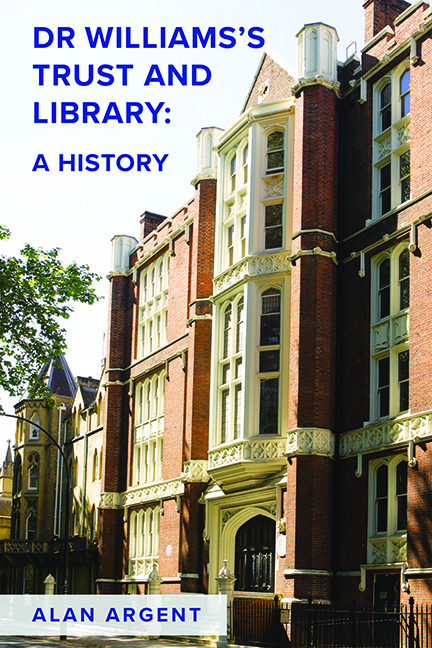Book contents
- Frontmatter
- Dedication
- Contents
- List of Illustrations
- Foreword
- Preface
- Abbreviations
- Notes on Dates, Money, Welsh Place Names and Publications
- Prologue
- 1 Dr Williams and His Will
- 2 Benjamin Sheppard, Receiver 1721–31: Faith, Fitness, and Diligence
- 3 Constructing the Library Building 1725–30: A Proper Plan
- 4 Francis Barkstead, Receiver 1731–47: Piety and Charity
- 5 John Cooper, Receiver 1748–62: Liberty and Liberal Dissent
- 6 Richard Jupp junior, Receiver 1762–95: A Very Respectable Body
- 7 Richard Webb Jupp, Receiver 1795–1850, and David Davison, Receiver 1850–7: Fashionable Sympathies Amid Increasing Light
- 8 Walter D. Jeremy, Receiver 1857–93: The Scrupulous Observer
- 9 Francis H. Jones, Secretary and Librarian 1886–1914: Introducing Order
- 10 Robert Travers Herford, Secretary and Librarian 1914–25: Application and Imagination
- 11 Stephen Kay Jones, Librarian 1925–46, and Joseph Worthington, Secretary 1925–44: A New Age with Old Strains
- 12 Roger Thomas, Secretary 1944–66 and Librarian 1946–66: Trusted Innovator
- 13 Kenneth Twinn, Secretary and Librarian 1966–76: Modest Dependability
- 14 John Creasey, Librarian, and James McClelland, Secretary, 1977–98: Mixed Blessings
- 15 David Wykes, Director 1998–2021: Past, Present, and Future
- 16 Dr Williams’s Trust: An Assessment
- Appendix 1 Trustees in 1723
- Appendix 2 Lists from Short Account (with later additions)
- Bibliography
- Index
6 - Richard Jupp junior, Receiver 1762–95: A Very Respectable Body
Published online by Cambridge University Press: 26 May 2022
- Frontmatter
- Dedication
- Contents
- List of Illustrations
- Foreword
- Preface
- Abbreviations
- Notes on Dates, Money, Welsh Place Names and Publications
- Prologue
- 1 Dr Williams and His Will
- 2 Benjamin Sheppard, Receiver 1721–31: Faith, Fitness, and Diligence
- 3 Constructing the Library Building 1725–30: A Proper Plan
- 4 Francis Barkstead, Receiver 1731–47: Piety and Charity
- 5 John Cooper, Receiver 1748–62: Liberty and Liberal Dissent
- 6 Richard Jupp junior, Receiver 1762–95: A Very Respectable Body
- 7 Richard Webb Jupp, Receiver 1795–1850, and David Davison, Receiver 1850–7: Fashionable Sympathies Amid Increasing Light
- 8 Walter D. Jeremy, Receiver 1857–93: The Scrupulous Observer
- 9 Francis H. Jones, Secretary and Librarian 1886–1914: Introducing Order
- 10 Robert Travers Herford, Secretary and Librarian 1914–25: Application and Imagination
- 11 Stephen Kay Jones, Librarian 1925–46, and Joseph Worthington, Secretary 1925–44: A New Age with Old Strains
- 12 Roger Thomas, Secretary 1944–66 and Librarian 1946–66: Trusted Innovator
- 13 Kenneth Twinn, Secretary and Librarian 1966–76: Modest Dependability
- 14 John Creasey, Librarian, and James McClelland, Secretary, 1977–98: Mixed Blessings
- 15 David Wykes, Director 1998–2021: Past, Present, and Future
- 16 Dr Williams’s Trust: An Assessment
- Appendix 1 Trustees in 1723
- Appendix 2 Lists from Short Account (with later additions)
- Bibliography
- Index
Summary
The practice of having two officers was retained. A receiver was appointed in 1762 and a secretary in 1766. Appointments of men from within a narrow field also continued. DWL's catalogue was improved. Breaking with precedent, a married librarian was appointed, and librarians were sometimes older than hitherto.
DWT Officers and DWL
After John Cooper's death in 1762, he was replaced as receiver by Richard Jupp junior (1728–99), an architect who had designed, among other buildings, the entrance and wings of Guy's Hospital (where George Sampson had once worked). From 1768, Jupp was also surveyor to the East India Company and became master of the Worshipful Company of Carpenters, a City of London livery company, to which he had been apprenticed. The trustee, Benjamin Avery, Guy's Hospital's most active governor, may have influenced Jupp's appointment.
Following Nathaniel Neal, the curiously named Oliver Cromwell (c. 1742–1821), a descendant of the Lord Protector, became secretary in 1766. This Cromwell, a solicitor with chambers in Essex Street, Strand, was also clerk to St Thomas’ Hospital. In addition, William Travers, DWT's agent in north Wales, died, to be succeeded by his brother, Edward, who resigned in 1769 when John Kenrick II was appointed. In 1767 Richard Jones (1728–1800) became librarian, having studied at Northampton under Doddridge and ministered in Cambridge and at Crosby Square, London. Jones was librarian for three years, then minister of Hanover Chapel, Peckham 1770–1800. In appreciation, the trustees gave £20 to Hoyle and £50 to Palmer, former librarians, for ‘new modelling the Catalogue’, and in March 1768 Samuel Baker (1711–78) of Covent Garden was engaged to finish the catalogue. If completed in six months, he was promised £200; if unfinished, he forfeited half that sum. Baker conceded in June that he needed another six months.
James Pickbourn (1736–1814) became DW librarian in 1770, completing the numerical catalogue in two years. In March 1773, Pickbourn was granted leave of absence to accompany ‘some young Gentlemen abroad to assist them in their studies’. The trustees engaged John Calder (1733–1815) as his deputy, reappointing both Pickbourn, though still absent, and Calder in December.
- Type
- Chapter
- Information
- Dr Williams's Trust and Library , pp. 95 - 109Publisher: Boydell & BrewerPrint publication year: 2022



